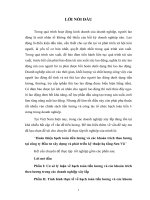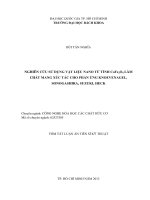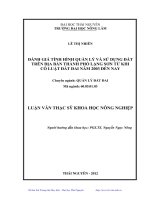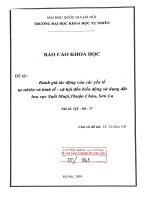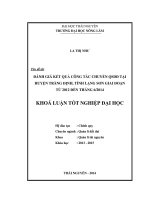Trích ly Polyphenol từ trà xanh sử dụng phương pháp trích có hỗ trợ vi sóng
Bạn đang xem bản rút gọn của tài liệu. Xem và tải ngay bản đầy đủ của tài liệu tại đây (208.77 KB, 4 trang )
Hội Nghị Khoa Học & Công Nghệ lần 9 Phân ban Công nghệ Hóa học
Trang
EXTRACTION OF POLYPHENOLS FROM GREEN TEA USING
MICROWAVE ASSISTED EXTRACTION METHOD
TRÍCH LY POLYPHENOL TỪ TRÀ XANH SỬ DỤNG PHƯƠNG PHÁP
TRÍCH CÓ HỖ TRỢ VI SÓN
G
Pham Thanh Quan, Tong Van Hang, Nguyen Hai Ha, Do Nguyen Tuyet Anh, Truong Ngoc Tuyen
Department of Organic Chemical Engineering, Faculty of Chemical Engineering, Ho Chi Minh City
University of Technology, 268 Ly Thuong Kiet street, District 10, HCM City, VietNam
TÓM TẮT
Dịch trích trà xanh được trích từ lá trà xanh sử dụng dung môi trích theo hai phương pháp trích thông
thường và phương pháp trích với sự hỗ trợ vi sóng .Một số yếu tố ảnh hưởng như dung môi (rượu-nước), tỉ
lệ nguyên liệu/dung môi (1/5-1/15), pH, nhiệt độ trích, thời gian trích và ngâm của hai phương pháp được
khảo sát. Ở cùng điều kiện khảo sát, phương pháp trích với sự hỗ trợ vi sóng cho hiệu suất cao với thời gian
ngắn hơn (82,6 % trong 360 giây ) phương pháp trích ly thông thường, 62,1% trong 180 phút. Dịch trích trà
xanh theo phương pháp trích có hỗ trợ vi sóng có hàm lượng polyphenol ( 36 %) cao hơn phương pháp thông
thường. Phương pháp trích có sự hỗ trợ vi sóng hữu hiệu hơn phương pháp trích thông thường về chất lượng,
thời gian và chi phí năng lượng.
ABSTRACT
Green tea extract (GTE) was extracted from raw green tea by using solvent extraction with traditional
heating method (SETM) and microwave-assisted extraction (MAE method). Several factors such as solvents
(alcohol aquaus), material: solvent ratio (1/5-1/15), pH, extraction temperature, immersion and extraction
time of both methods were studied. In same conditions, MAE method gave higher yield in much shorter time
than SETM, 82.56% in 360 seconds and 62.14% in 180 minutes, respectively. GTE from MAE method had
total polyphenols concentration higher (36%) than that of SETM. Consequently, MAE method was found to
be much more effective than SETM in quality of GTE, time and energy consumption.
Keywords: Polyphenols, green tea, green tea extract, extraction, microwave assisted extraction.
1. INTRODUCTION
Tea (Camellia sinensis) is native to the East
Asia region. Camellia Sinensis, a member of the
Theaceae family, is an evergreen, usually picked
as young shoots in cultivation. Its first recorded
use dates from the fourth century A.D. in China
[Tong.V.Hang 1985]. Nowaday, tea with its
variety products is one of the most widely
consumed beverages in the world. Main tea
producers concentrated in equatorial regions.
Three biggest tea producers and exporters are
China, India and Vietnam.
Young shoots tea (green tea) contains many
polyphenolic compounds, up to 30-40 percent of
the extractable solids of dried green tea leaves,
with most of the polyphenols being flavanols more
commonly known as catechins. The primary
catechins in green tea are epicatechin (EC),
epicatechin-3-gallate (ECG), epigallocatechin
(EGC), and epigallocatechin-3-gallate (EGCG)
(Fig. 1) [Tong.V Hang 1985], [Fujikia et al 2002],
[Hemiway et al 1992].
Recently green tea as a healthy beverage has
attracted science attention for its anticancer and
antioxidation activities [Weisburger 2000].
Polyphenols in green tea are believed as good free
radical scavengers. Several clinical studies found
them to be active in cancer prevention in several
ways and polyphenols have been recently
recognized as functionally active molecules,
possessing antioxidant, anticancer, antimutagenic
1
Hội Nghị Khoa Học & Công Nghệ lần 9 Phân ban Công nghệ Hóa học
.
Trang
properties, as well as exerting protective effects
against cardiovascular and other diseases [Brown,
1999], [Aldini et al 2003], [Gupta et al 2002], [Jun
Cai et al 2002], [Azam et al 2004].
Epigalogatechin –3- gallate (EGCG)
Epicatechin –3- gallate (ECG)
Epicatechin (EG)
Epigalocatechin (EGC)
Figure 1. Catechins in green tea extracts
Vietnam is one of biggest tea producers and
exporters in the world, however main export
products is raw material or traditional products
such as black tea, oolong tea and green tea. Green
tea extract is still new in Vietnam market and also
new in research and application.
HO
OH
O
H
H
O
OH
OH
CO
OH
OH
OH
OH
Green tea extract was prepared using several
different techniques, including solvent extraction,
soxhlet extraction; microwave assisted extraction,
solid-phase extraction, and supercritical fluid
extraction. Each technique has its own advantages
and problems, in small-scale produce, microwave
method seems to be a reasonable method that
helps reduce time and save energy for producer.
In this article, several factors involving in
microwave-assisted extraction were studied and
compare to those of solvent extraction using
traditional heating method.
HO
OH
O
H
H
O
OH
OH
CO
OH
OH
OH
2. MATERIALS AND METHODS
Reagents
Fresh green tea (picked as shoots with two or
three leaves) was purchased from Ladotea (Lam
Dong Vietnam). Folin - Ciocalteau agent (Merck),
citrate - phosphate pH buffer (Merck), ethanol and
other chemical in AP grade
HO
OH
O
H
H
OH
OH
OH
Green tea extraction method
Microwave assisted extraction (MAE): Fresh
green tea was collected as shoot on fields. 100g of
fresh green tea were cut to 1 - 1.5mm size then
immerse in solvents (1:5 to 1:15 g/ml) for a
certain time (0 - 90 minutes). Then it was
transferred to flask, adjusted pH, and brewed in
microwave oven (450W) (times: 300- 420s),
radiation is done at regular intervals (30s interval)
to keep temperature not rise above 70
o
C. After
that, the infusion was let cool down to room
temperature, filtered to separate solid and
concentrated by rotary vacuum evaporation to
50ml. Final infusion was stored in refrigerator at
4
o
C.
HO
OH
O
H
H
OH
OH
OH
OH
Solvent extraction using traditional heating
method (SETH): Extraction procedure was carried
out similar to MAE, except extraction time was
180 minutes.
2
Hội Nghị Khoa Học & Công Nghệ lần 9 Phân ban Công nghệ Hóa học
Trang
Total polyphenols determination
Total polyphenols concentrated (TPC) in
infusion were spectrophotometrically determined
measuring absorption after using Folin-Ciocalteau
reagent, using Jenway 6505 UV-VIS
Spectrophotometer at 700 nm. GTE composition
was identified by TLC.
3. RESULTS AND DISCUSSION
Effect of extraction time
Fig 2. show that when using MAE extraction
yield increases with extraction time and get the
highest at 360 seconds, 82.56%, compare to
61,14% of that of SETH (highest yields in 180
minutes extraction). Increasing extraction time in
MAE did not help increase yield. In some
experiments, when increasing extraction time
above 420 seconds, extraction yield dropped
below 50%, could be due to effect of long
radiation of microwave to polyphenols molecules.
76.000
77.000
78.000
79.000
80.000
81.000
82.000
83.000
84.000
300 360 420
Time (s)
Extraction Yield (%)
Figure 2. Effect of time to TPC
68.000
70.000
72.000
74.000
76.000
78.000
80.000
82.000
84.000
03060
Immersion time (minute)
Extraction yield (%)
Figure 3. Effect of immersion time to TPC
Effect of immersion time
Immersion before extracting help increase
extraction yield, but not significant. Immersion
gives time to solvent to complete absorbed into
material. Yield from 73,64% when not immersion
went to 82,56% when immersion in 30 minutes.
Fig 3. shows that immersion time doubles (60
minutes), extraction yield slightly decreased to
81.59%. In this factor, SETH showed the same
change trend, although with lower yield.
0
50
100
2 2.5 3 3.5 4
pH
Extraction Yield (%)
Figure 4. Effect of pH to TPC
0
20
40
60
80
100
1:5 1:10 1:15
Material : solvent ratio
Extraction Yield (%)
Figure 5. Effect of material: solvent ratio to TPC
Effect of pH
Polyphenols are strong antioxidants, so they
are easily oxidated in high pH. Extracting is
usually carried out at acid pH because of high
antioxidant activities in neutral and base pH. The
lower pH is, the better polyphenols are protected,
and the higher yield gets. In Fig 4, highest yield at
pH 2.5 (82.56%), slightly lower at 2 (79.09%), but
continuously decreased above pH 2.5, at pH 6,
only 52,50%. The results were similar in SETH
with highest yield is 74.57% at pH 3.
3
Hội Nghị Khoa Học & Công Nghệ lần 9 Phân ban Công nghệ Hóa học
.
Trang
Effect of material: solvent ratio
REFERENCES
1. Hemingway, R.W, Larks, 1992, Polyphenol
plant, Lees, G.L
Polyphenols in material go into solvents by
diffusion, so extraction yield increase with
material: solvent ratio. In Fig. 5, ratio 1:10 gave
highest yield (82,56%), 1:5 only 43.28%. But
when increasing ratio to 1:15, yield downed to
59,18%, because more time need to heat a large
volume of solvents (extraction time in MAE is
only 360 seconds). In SETH, ratio lower than 1:5
gave very low yield, material: solvent ratio from
1:5 to 1:10 had not get significant effect to
extraction yield because of long extraction time
(180 minutes).
2. Tong Van Hang, 1985, Co so sinh hoa va ki
thuat che bien tra, Tp.HCM
3. Michael D. Brown, 1999, Green Tea (Camellia
Sinensis) Extract and Its Possible Role in the
Prevention of Cancer, ND Alternative
Medicine Review, Volume 4, Number 5
4. Hirota Fujikia, Masami Suganumab, Kazue
Imaic, Kei Nakachic, 2002, Green tea: cancer
preventive beverage and/or drug, Cancer
Letters 188, 9–13
5. S. Gupta, B. Saha, A.K. Giri, Comparative
antimutagenic and anticlastogenic effects of
green tea and black tea: a review, 2002,
Mutation Research 512, 37–65
6. Yuko Yoshida, Masaaki Kiso, Tetsuhisa Goto,
1999, Effeciency of the extraction of catechins
from green tea, Food Chemistry 67, 429±433
76
77
78
79
80
81
82
83
84
60o 70o 80o
Alcohol
Extraction Yield (%)
7. John H. Weisburger, 2000, Tea and health: a
historical perspective, Cancer Letters 114
(1997) 315-317
8. Jen – Kun Lin, Yu – Chih Liang, Cancer
Chemoprevention by Tea Polyphenols, Vol. 24,
No. 1, pp. 1-13.
9. Giancarlo Aldini, Kyung-Jin Yeum, Marina
Carini, Norman I. Krinsky, and Robert M.
Russell, 2003, (-)-Epigallocatechin-(3)-gallate
prevents oxidative damage in both the aqueous
and lipid compartments of human plasma,
Biochemical and Biophysical Research
Communications 302, 409–414
Figure 6. Effect of solvents to TPC
Effect of solvents
The most effective solvent in this experiment
was ethanol 70
o
. Extraction yield when using
ethanol 70
o
was 82.56%, higher than using ethanol
80
o
(81,36%) and ethanol 60
o
(78.64%). However,
these changes did not give much effect to
extraction procedure.
10. Yu-Jun Cai, Lan-Ping Ma, Li-Fen Hou, Bo
Zhou, Li Yang, Zhong-Li Liu, 2002,
Antioxidant effects of green tea polyphenols on
free radical initiated peroxidation of rat liver
microsomes, Chemistry and Physics of Lipids
120, 109_/117
4. CONCLUSION
11. S. Azam , N. Hadi , N.U. Khan , S.M. Had,
2004, Prooxidant property of green tea
polyphenols epicatechin and epigallocatechin-
3-gallate: implications for anticancer
properties, Toxicology in Vitro 18 (2004) 555–
561
Compare to solvent extraction using traditional
heating method, in solvents, immersion time, pH,
material: solvent ratio factors, microwave assisted
extraction gave similar changing trend, but with
higher yield (36% average). In time consumption,
MAE is superior to SETM with extraction time
only 360 seconds (6 minutes- and 36 minutes
total, including immersion time), while extraction
time in SETM is 180 minutes – 210 minutes total.
Consequently, MAE is suitable method to extract
green tea for further investigation.
4
